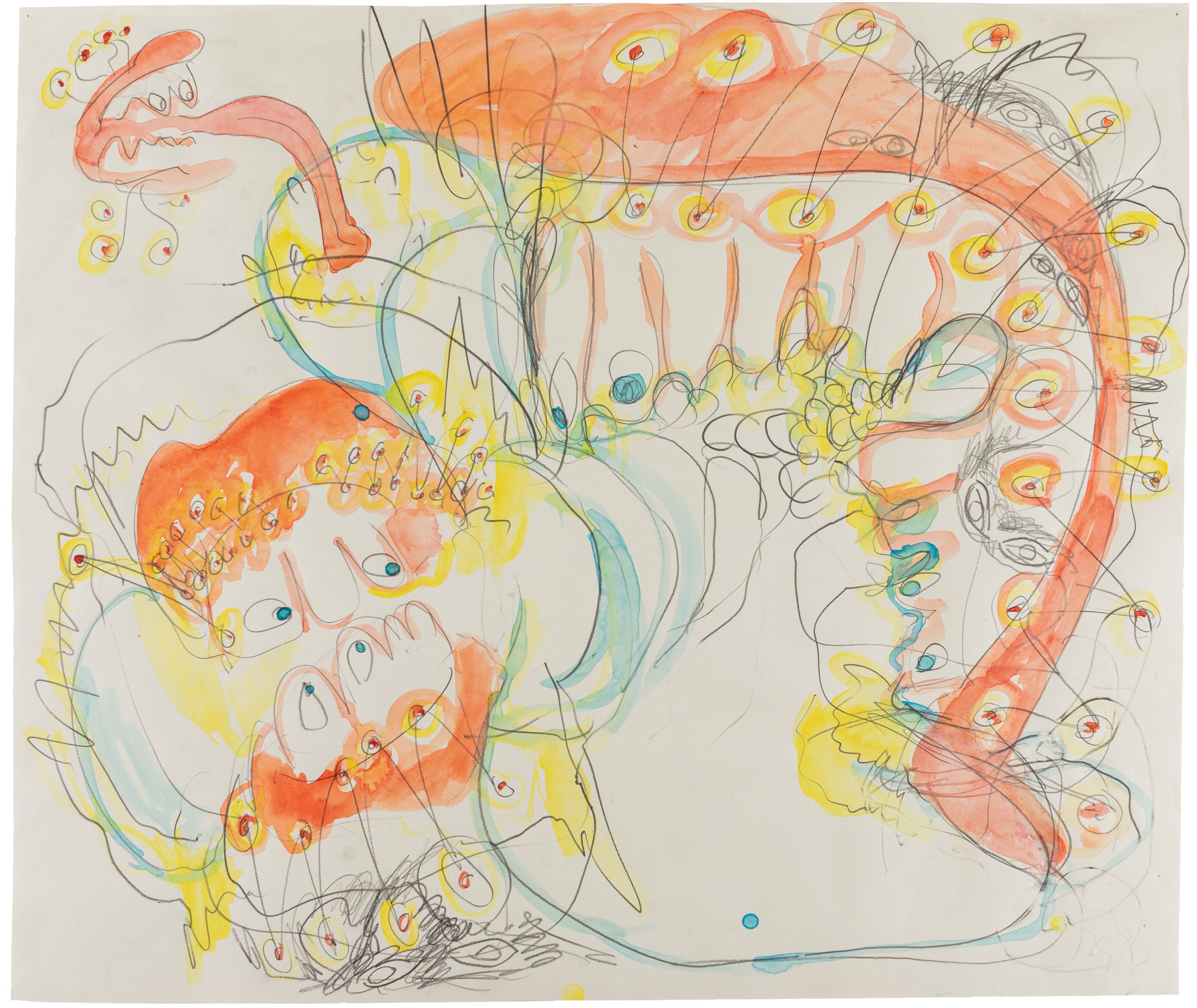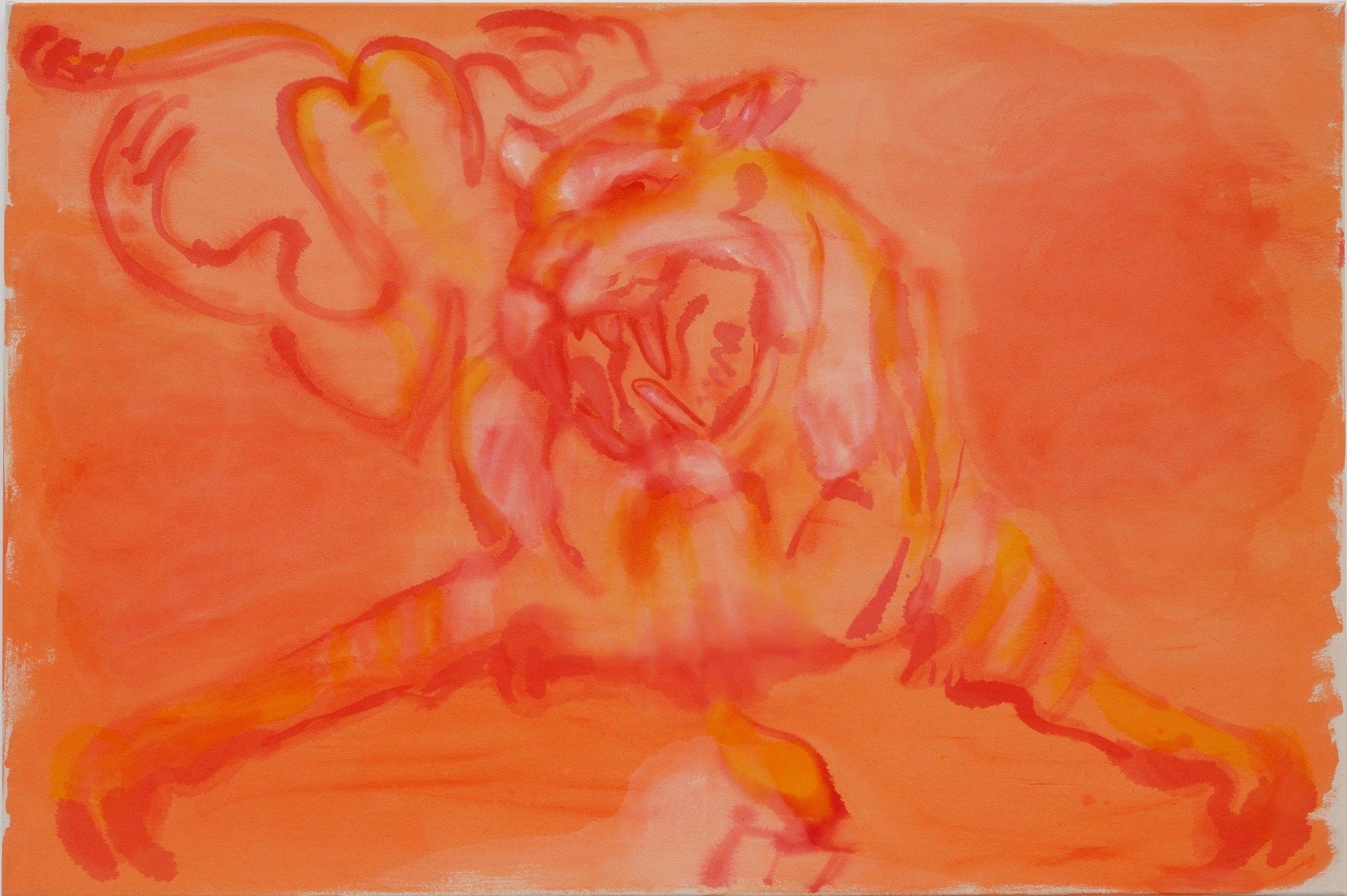Andrea Éva Győri
Squeeze and Release
| Venue: | acb Attachment |
| Date: | May 05 – Jun 16, 2023 |
| Opening: | May 04, 2023, 18:00–21:00 |
Description
acb Gallery presents Andrea Éva Győri’s second solo exhibition to commemorate the one-year anniversary of her passing.
Andrea Éva Győri (1985 — 2022) was born in Hungary and lived in the Netherlands. She studied painting at the fine art academies of Budapest and Stuttgart and was the recipient of several international scholarships and artist-in-residence opportunities. Her signature stylistic trait is the loose, rapid, straightforward combination and formal wealth of pencil drawing and watercolor on paper, but she also worked in various other media, such as performance, video, and gouache paintings on canvas, as well as ceramic sculptures.
The exhibition at acb Attachment introduces her pencil and watercolor series from 2018-19, along with thematically related ceramic sculptures. Győri’s oeuvre is characterized by an analytical, intimate attitude, articulating the corporeal-spiritual processes associated with the experience of relaxation techniques employed with the purpose of self-examination and self-healing during this period. In her work, she attempted to explore the interrelation between emotional experience, the creative imagination, and the physicality of the body. After the diagnosis of her illness, she intensified her research into the interaction of her body image, her sexuality, and her (psychosomatic) symptoms, influenced by the experience of her own body and her traumas. Questions about what the body can know about itself that even the conscious part of the brain does not recognize, whether this subconscious layer can be accessed and controlled through meditation practices, and whether thoughts and visions can trigger changes in the functioning of the body were all actively present in her art in these years.
During this period Győri spent several hours a day practicing mind control, autogenic training, and progressive muscle relaxation techniques, which seek to relieve anxiety through meditation or by means of physical exercises stimulating rhythmic muscle movement. The mechanism of these therapeutic tension-release techniques is also referred to in the title of the exhibition, Squeeze and Release, as well as the titles of several groups of works, such as Deep Jaw Relaxation, Deep Muscle Relaxation. On one hand, these words refer to the liminality between actively tensed muscles and the conscious layer of the psyche, and the passive, flaccid body and the unconscious on the other, while also expressing the sense of relief experienced through these therapeutic techniques. Andrea Éva Győri’s creative method is characterized by an interdisciplinary attitude of analysis and cognition, whereby the artist synthesizes community experiences with her own experience. In 2019, she organized events at her studio that included the application of these relaxation practices in a community setting. On long rolls of paper, she captured the participants’ tense facial muscles, clenched teeth, and tensed limbs. The series in acb Attachment is a synthesis of these observations and the artist’s own experiences.
Upon entering the exhibition space, the first thing the viewer encounters is the series entitled Study of Senses, in which Győri depicts the sense organs of sight, hearing, and smell, as well as the functioning of the nervous system. The maps of the senses are followed by Between the Itchy Nose and Refreshing Program, a series that shows the stages of a panic attack. Here the artist unfolds the narrative in flow charts, similar to the toolset of comic books, often combining visual elements with text. Győri has suffered from panic attacks since her youth, and such an episode is usually preceded by the itching of her nose. The images in this series of 9 depict a state of total loss of control, which Győri breaks down into parts in an attempt to render the terrifying experience of itchy nose, intense palpitations, shortness of breath, dizziness, sweating, body tremors and loss of sight harmless and comprehensible by means of interpretation. The series Deep Jaw Relaxation, displayed on the central wall of the room, differs from the two-dimensional organization of the other works in the space, which communicate in flow charts. The energetic compositions of jaws bursting open from exertion exude tension, helplessness, and anger, but also evoke one of the above-mentioned relaxation techniques, progressive muscle relaxation, more specifically, the step of clenching and unclenching the jaw and facial muscles.
This series is closely related to the ceramic sculptures in the room (Lips 1-3), whose chunky, undulating surfaces, bearing the artist’s fingerprints and handprints, convey the sensual experience of working with clay. These unfurling ceramic lips also bear the tension evident in the series of paintings, and also represent one of the central themes of Győri’s oeuvre: sexuality. The rhomboid, cavernous depressions between the red-painted, glossy glazed lips evoke female genitalia framed by protruding, aggressive teeth. Tongues resembling a yellow and blue flag flutter between the lips of Tongue 1-2. The use of red, yellow, and blue is also the most common color combination in Andrea Eva Győri’s watercolors, where red is usually used to depict lips and genitals as well as sexual arousal. The yellow color is usually associated with secretions produced by the human body – such as semen, vaginal discharge, sweat, saliva –, or often with disease, toxins, the (harmful) processes inside the body, such as the proliferation of cancer cells. Győri uses blue to indicate the energy field of the depicted bodies. In many cases, she also uses this color as a background for text bubbles, thus articulating the narrative representation in her compositions, and the blue color also symbolizes visions and imagination, thought in her works. In the exhibition, Győri’s works present the experience of relaxation techniques by focusing first on a single part of the body, the mouth, and then continuing to explore the whole body experience in the 10-part group of works entitled Deep Muscle Relaxation. This series also conveys the sensations of the tension-release relaxation technique to the spectator, but here the artist already visualizes both the physical pain and the emotional burden of the symptoms of her disease: the spectator is confronted with the burden of illness via the image of elephants weighing down on chests.
Andrea Éva Győri (1985, Budapest — 2022, Rotterdam) studied at the Hungarian University of Fine Arts and the Staatliche Akademie der Bildenden Künst in Stuttgart, then at HONGIK University in Seoul. In 2017-19 she was a fellow of the Jan Van Eyck Academy in Maastricht, in 2019 she was a resident student at Künstlerhaus Schloss Balmoral in Bad Ems, and in 2020 she was awarded the Mondriaan Fonds grant. She had solo exhibitions at the MANIFESTA 11 biennale in Zurich in 2016, Grimm Museum Berlin in 2017, Vleeshal Center for Contemporary Art Middelburg in 2018, IKOB - Museum of Contemporary Art Belgium in 2019, among others. Her works were featured in numerous group exhibitions, at Haus der Kunst in Munich, Witte de With Center for Contemporary Art in Rotterdam and Bonnefantenmuseum in Maastricht, to name a few. In 2019 she received the Esterházy Art Award.

